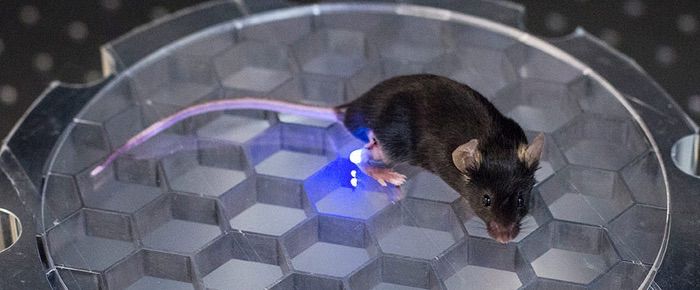 This mouse’s own body transmits energy to an implantable device that delivers light to stimulate leg nerves in a Stanford optogenetics project. (Image credit: Austin Yee)
This mouse’s own body transmits energy to an implantable device that delivers light to stimulate leg nerves in a Stanford optogenetics project. (Image credit: Austin Yee)
- Written by Stanford News
Stanford engineers develop a wireless, fully implantable device to stimulate nerves in mice
FeaturedA miniature device that combines optogenetics – using light to control the activity of the brain – with a newly developed technique for wirelessly powering implanted devices is the first fully internal method of delivering optogenetics. The blue glowing device the size of a peppercorn can activate neurons of the brain, spinal cord or limbs in mice and is powered wirelessly using the mouse's own body to transfer energy. Represents collaboration PI and Post Docs, multi-discipline, Known4 Labs.
Developed by a multidisciplinary Stanford Bio-X team, their paper in Nature Methods describes the device is the first to deliver optogenetic nerve stimulation in a fully implantable format.
"This is a new way of delivering wireless power for optogenetics," said Ada Poon, an assistant professor of electrical engineering at Stanford. "It's much smaller and the mouse can move around during an experiment."
The device can be assembled and reconfigured for different uses in a lab, and the design of the power source is publicly available.
 Read the full article at Stanford News.
Read the full article at Stanford News.
Visible Legacy Comment
This collaboration was facilitated by the outreach of Post Docs seeking collaboration with other disciplines. Professor Poon networked with Post Docs Logan Grosenick in the Deisseroth Lab and Kate Montgomery in the Delp Lab. Dr Montgomery drew in Professor Delp and co-authored a paper with Alexander Yeh in the Poon Lab. Finding multidisciplinary collaborators is an important need for researchers and a key objective of Visible Legacy.
See the latest research from the ecosystem by exploring the map below!
Additional Info
-
Navigator:
 Explore the map in Navigator
Explore the map in Navigator - Widget:
- Caption: Engineers in Prof. Ada Poon’s laboratory have developed an efficient wireless powering system that harnesses the dielectric properties of biological tissue to charge medical implants. The technology uses the tissue to focus energy from a power transmitter to the implanted receiver. The system was initially developed and tested for small animal studies of neuronal signaling. In this setting, wireless charging allows the animals to move untethered to a power source, thereby facilitating chronic experiments and studies of social interaction. It could also be applied to other types of electrical or optogenetic stimulation experiments.
Related items
- The future of health care is in our cells
- Federal funding will help WSU professor develop technology to recover rare earth elements
- Unlocking the brain: Peptide-guided nanoparticles deliver mRNA to neurons
- Scientists Get to the Bottom of COVID’s Worst Pediatric Complication
- WSU-inspired national gene-editing task force begins work
